
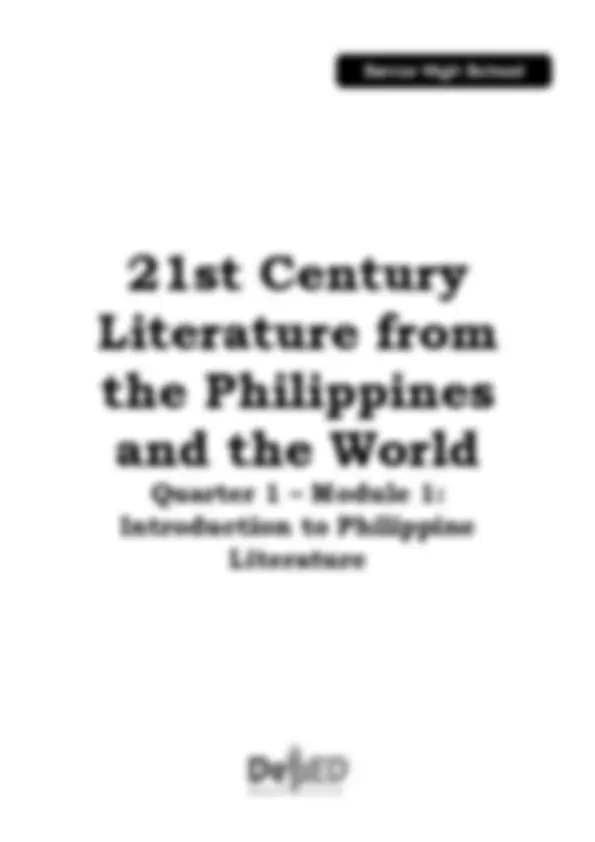
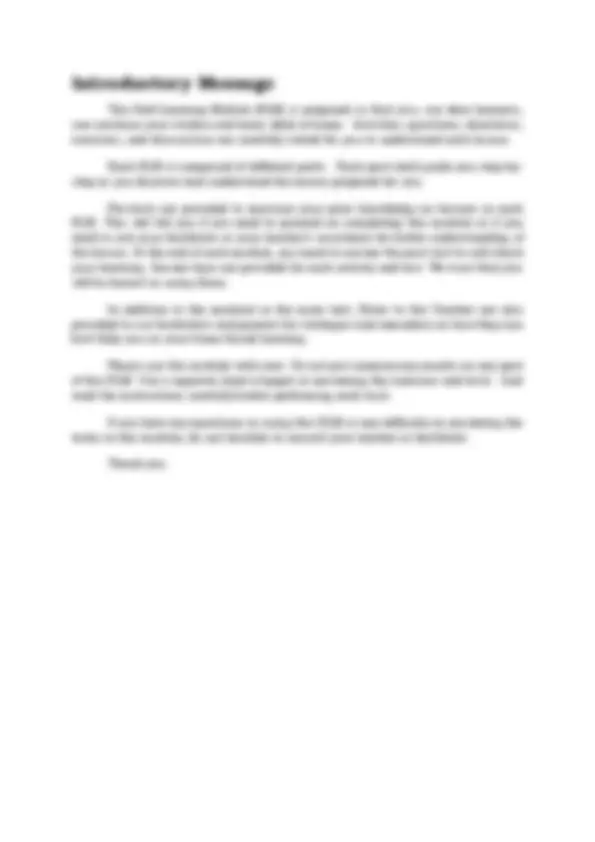
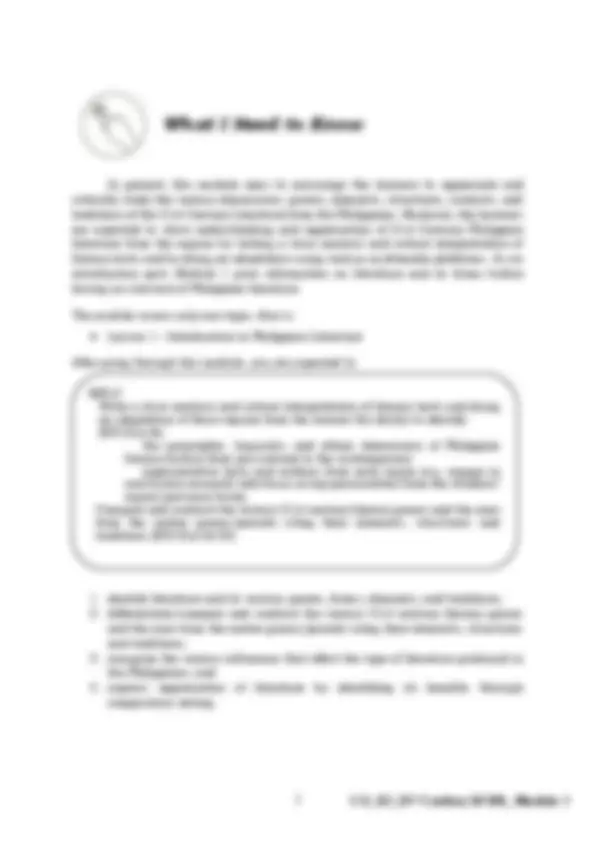
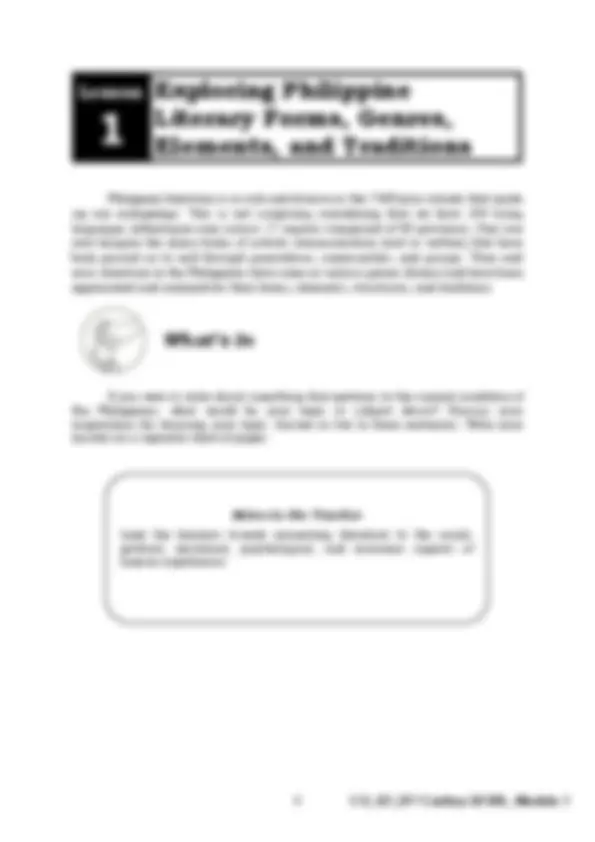
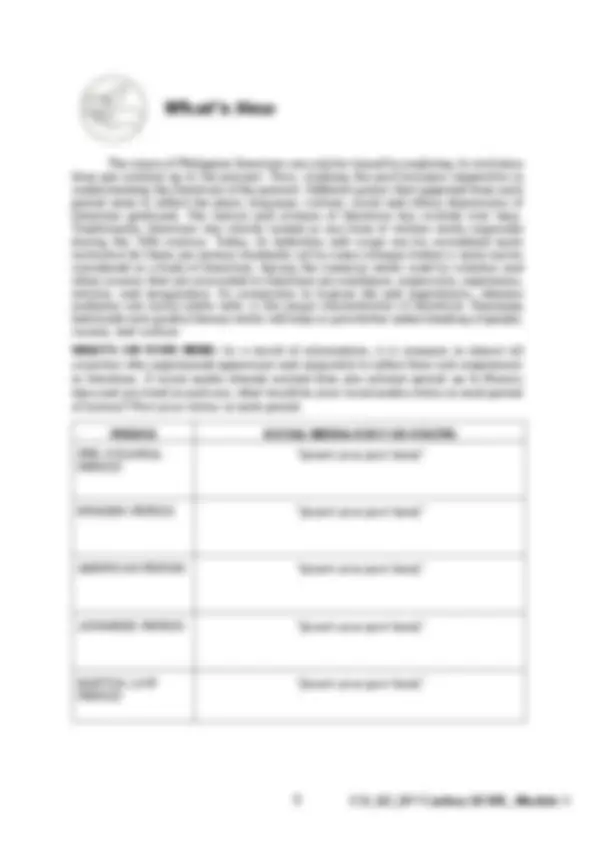
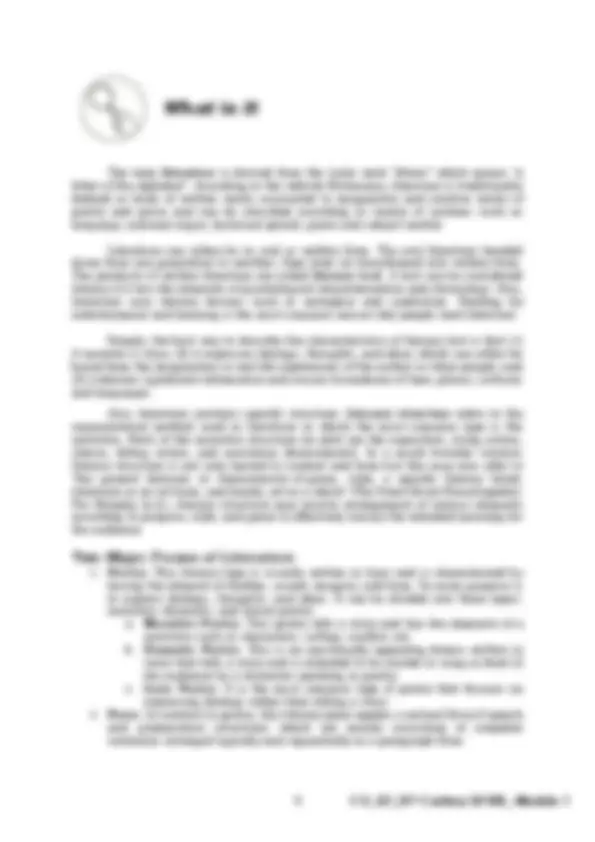
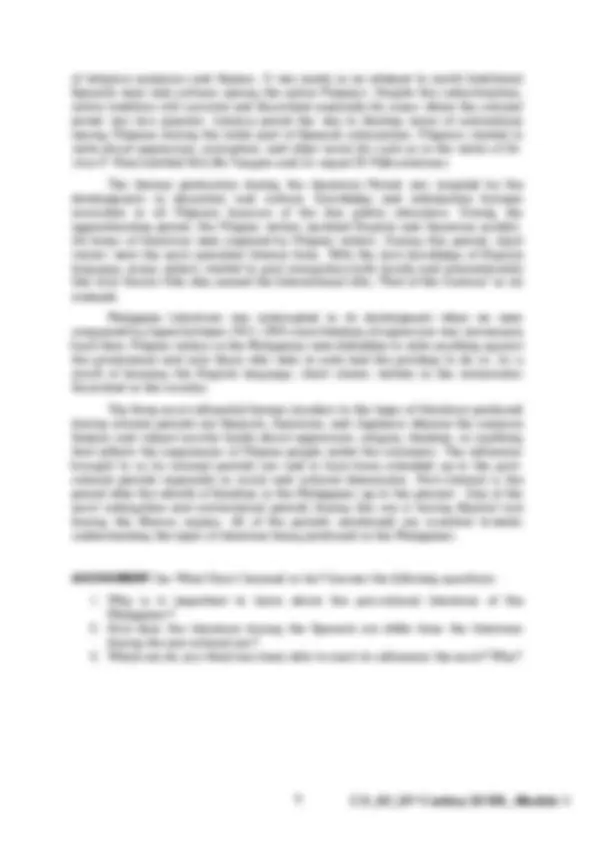
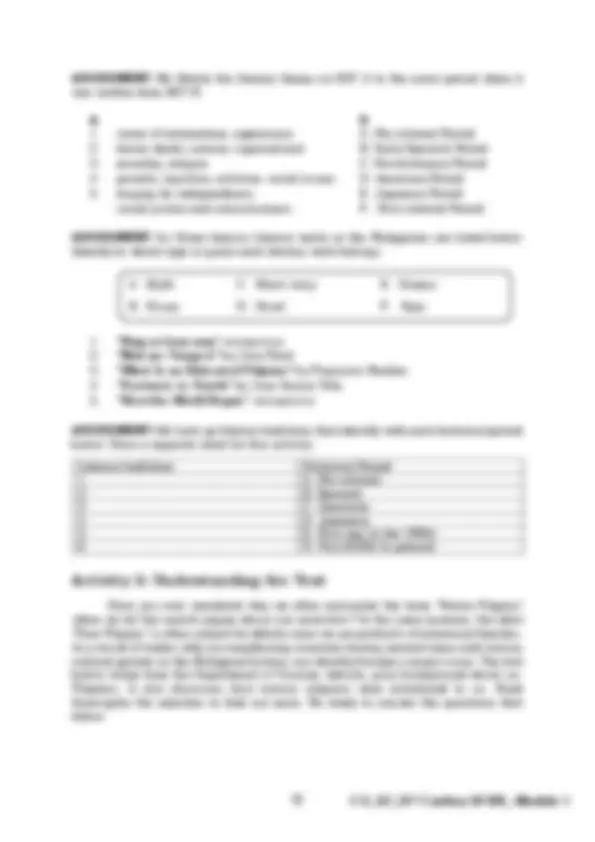
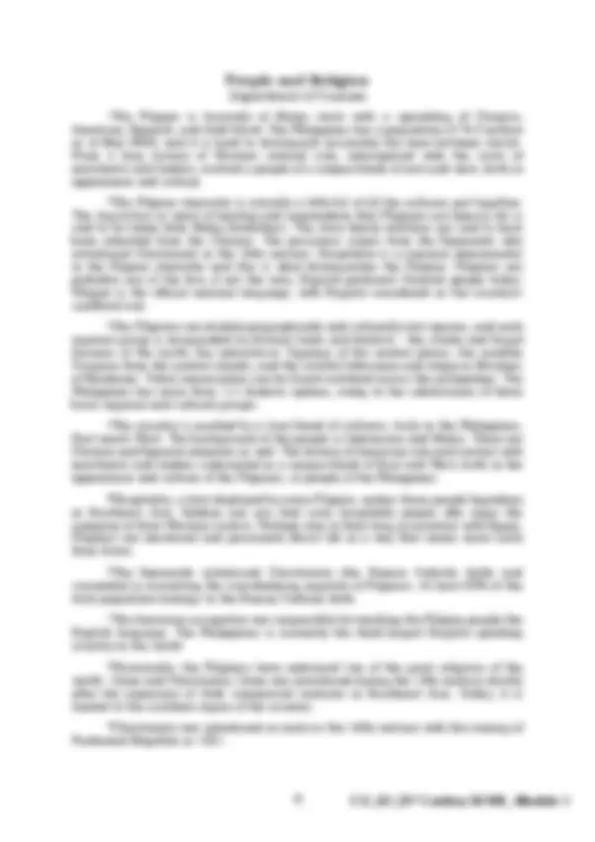
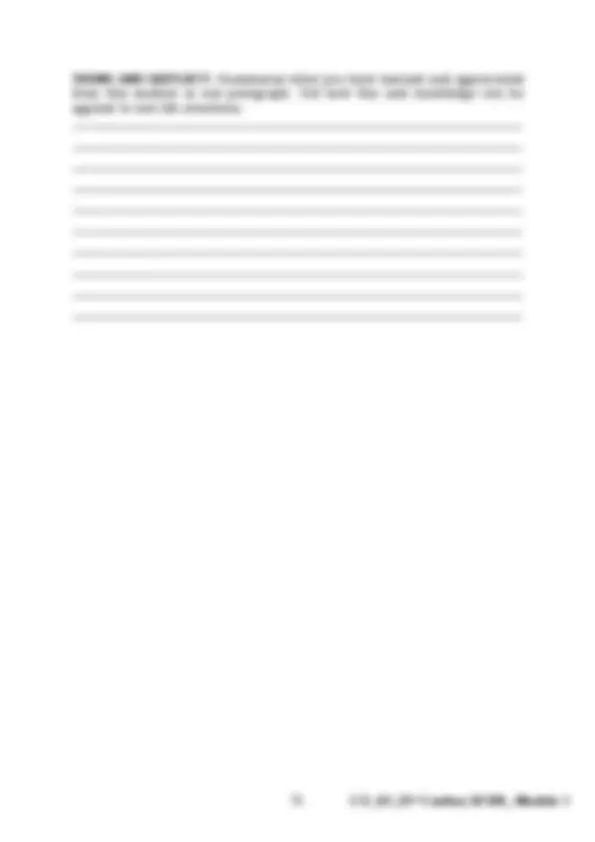
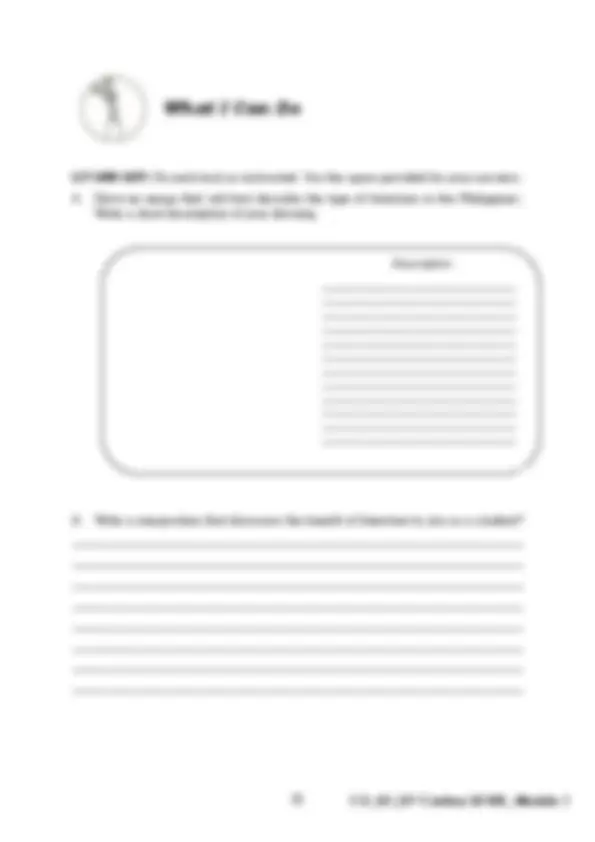
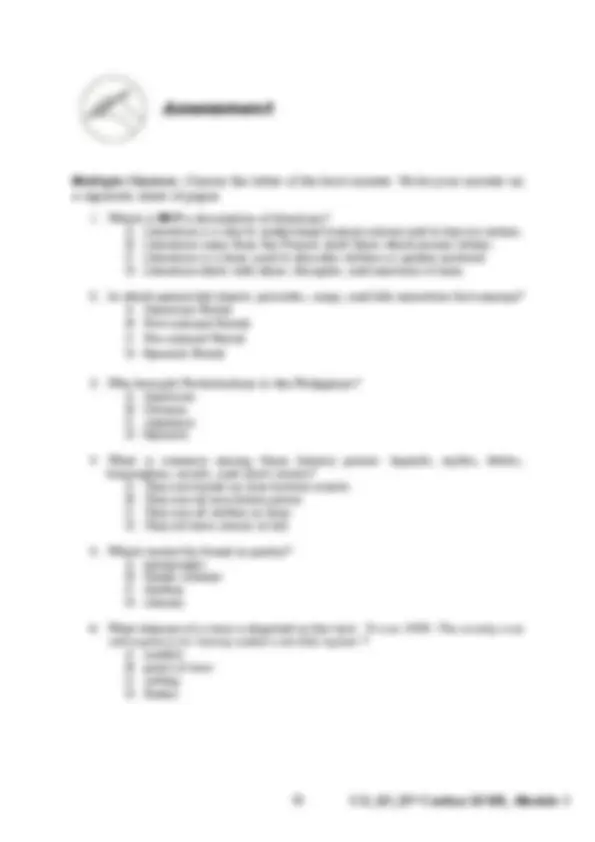
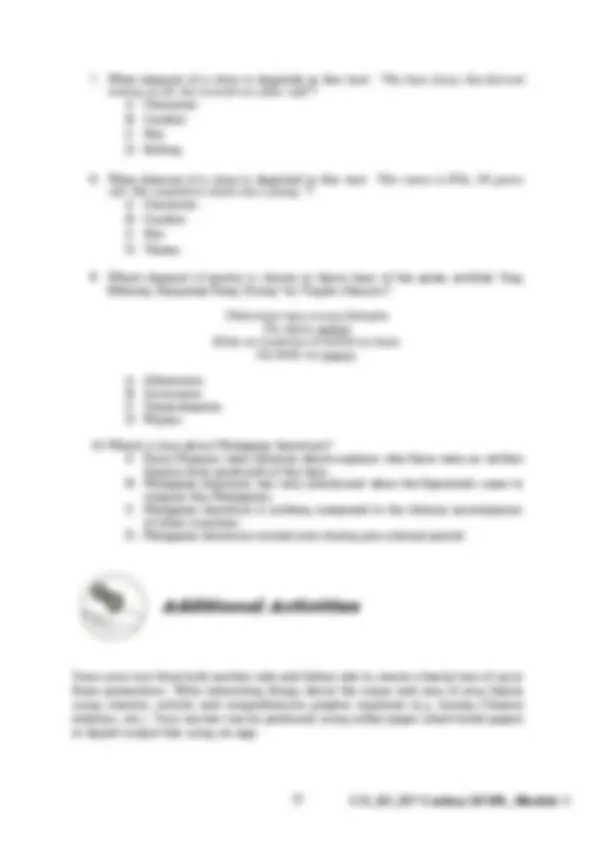
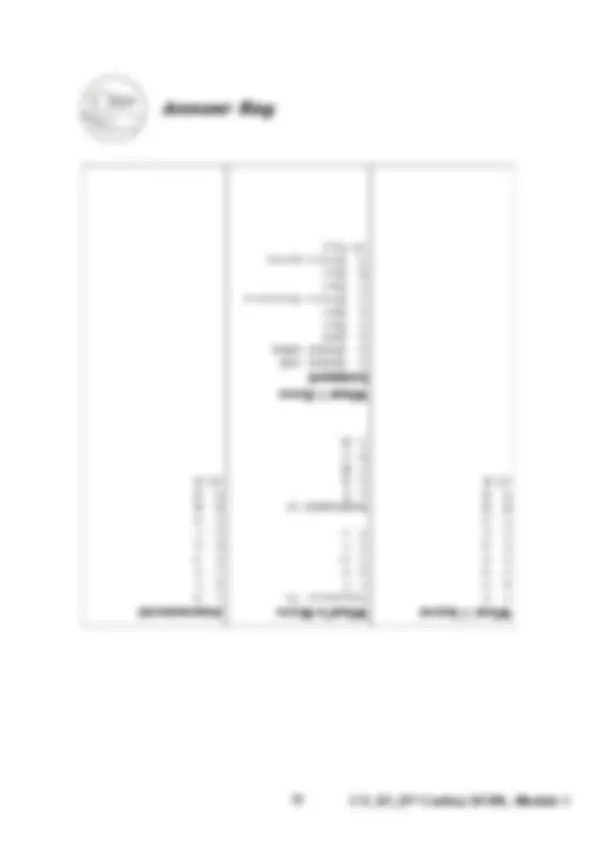
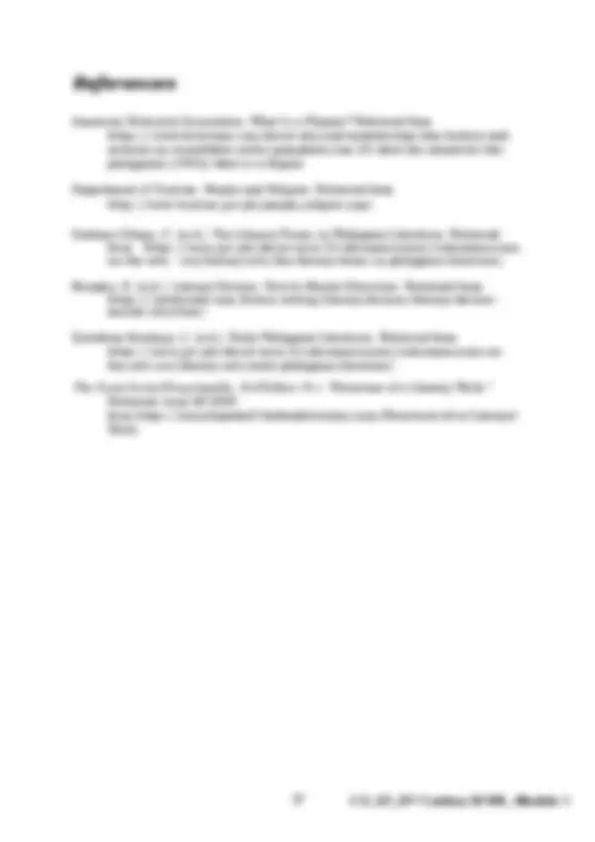
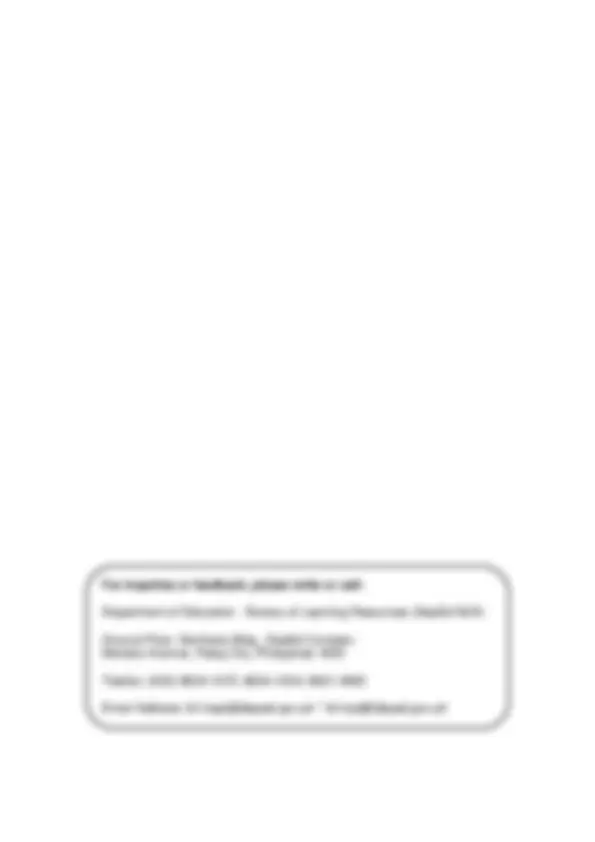


Study with the several resources on Docsity

Earn points by helping other students or get them with a premium plan


Prepare for your exams
Study with the several resources on Docsity

Earn points to download
Earn points by helping other students or get them with a premium plan
Community
Ask the community for help and clear up your study doubts
Discover the best universities in your country according to Docsity users
Free resources
Download our free guides on studying techniques, anxiety management strategies, and thesis advice from Docsity tutors
About Philippine Literature...you can manage about it..and you learn about this module..i hope you learn more
Typology: Summaries
1 / 24

This page cannot be seen from the preview
Don't miss anything!

















21st Century Literature from the Philippines and the World– Grade 12 Alternative Delivery Mode Quarter 1 – Module 1: Introduction to Philippine Literature First Edition, 2020 Republic Act 8293, section 176 states that: No copyright shall subsist in any work of the Government of the Philippines. However, prior approval of the government agency or office wherein the work is created shall be necessary for exploitation of such work for profit. Such agency or office may, among other things, impose as a condition the payment of royalties. Borrowed materials (i.e., songs, stories, poems, pictures, photos, brand names, trademarks, etc.) included in this module are owned by their respective copyright holders. Every effort has been exerted to locate and seek permission to use these materials from their respective copyright owners. The publisher and authors do not represent nor claim ownership over them. Published by the Department of Education Secretary: Leonor Magtolis Briones Undersecretary: Diosdado M. San Antonio Printed in the Philippines by ________________________ Department of Education – NCR Office Address: Misamis St., Bago Bantay, Quezon City, Metro Manila Telefax: (632) 8929- 0153 E-mail Address: depedncr@deped.gov.ph Development Team of the Module Writers: Mirasol C. Eugenio, PhD & Astrid E. Arevalo Editor: Marilou S. Syjueco Reviewers: Nenita J. Rivera, Melibeth D.C. Ruiz, Irene M. Raya, Felisa I. Salud, Aprilyn G. Reyes, Anna Margarita L. Arcega, Nerissa B. Mendoza, Ralph Joseph Quiaoit Layout Artists: Mirasol C. Eugenio, Astrid E. Arevalo, Ana Lisa M. Mesina Management Team: Malcolm S. Garma Genia V. Santos Dennis M. Mendoza Micah S. Pacheco Josefina M. Pablo Dalisay E. Esguerra Hilda C. Valencia
This Self-Learning Module (SLM) is prepared so that you, our dear learners, can continue your studies and learn while at home. Activities, questions, directions, exercises, and discussions are carefully stated for you to understand each lesson. Each SLM is composed of different parts. Each part shall guide you step-by- step as you discover and understand the lesson prepared for you. Pre-tests are provided to measure your prior knowledge on lessons in each SLM. This will tell you if you need to proceed on completing this module or if you need to ask your facilitator or your teacher’s assistance for better understanding of the lesson. At the end of each module, you need to answer the post-test to self-check your learning. Answer keys are provided for each activity and test. We trust that you will be honest in using these. In addition to the material in the main text, Notes to the Teacher are also provided to our facilitators and parents for strategies and reminders on how they can best help you on your home-based learning. Please use this module with care. Do not put unnecessary marks on any part of this SLM. Use a separate sheet of paper in answering the exercises and tests. And read the instructions carefully before performing each task. If you have any questions in using this SLM or any difficulty in answering the tasks in this module, do not hesitate to consult your teacher or facilitator. Thank you.
In general, this module aims to encourage the learners to appreciate and critically study the various dimensions, genres, elements, structures, contexts, and traditions of the 21st Century Literature from the Philippines. Moreover, the learners are expected to show understanding and appreciation of 21st Century Philippine literature from the regions by writing a close analysis and critical interpretation of literary texts and by doing an adaptation using various multimedia platforms. As an introductory part, Module 1 gives information on literature and its forms before having an overview of Philippine literature. The module covers only one topic, that is: ● Lesson 1 – Introduction to Philippine Literature After going through this module, you are expected to:
Write a close analysis and critical interpretation of literary texts and doing an adaptation of these require from the learner the ability to identify: (EN12Lit-Ib) the geographic, linguistic, and ethnic dimensions of Philippine literary history from pre-colonial to the contemporary representative texts and authors from each region (e.g. engage in oral history research with focus on key personalities from the students’ region/province/town) Compare and contrast the various 21st century literary genres and the ones from the earlier genres/periods citing their elements, structures and traditions (EN12Lit-Id-25)
1 Exploring Philippine Literary Forms, Genres, Elements, and Traditions Philippine literature is as rich and diverse as the 7500 plus islands that make up our archipelago. This is not surprising considering that we have 183 living languages (ethnologue.com) across 17 regions comprised of 82 provinces. One can only imagine the many forms of artistic communication (oral or written) that have been passed on to and through generations, communities, and groups. Then and now, literature in the Philippines have come in various genres (forms) and have been appreciated and analyzed for their forms, elements, structures, and traditions.
If you were to write about something that pertains to the current condition of the Philippines, what would be your topic or subject about? Discuss your inspirations for choosing your topic. Answer in two to three sentences. Write your answer on a separate sheet of paper.
Lead the learners toward connecting literature to the social, political, emotional, psychological, and economic aspects of human experiences.
The term literature is derived from the Latin word "littera" which means "a letter of the alphabet". According to the website Britannica, literature is traditionally defined as body of written works associated to imaginative and creative works of poetry and prose and can be classified according to variety of systems such as language, national origin, historical period, genre and subject matter. Literature can either be in oral or written form. The oral literature handed down from one generation to another, then later on transformed into written form. The products of written literature are called literary text. A text can be considered literary if it has the elements of psychological characterization and chronology. Also, literature uses literary devices such as metaphor and symbolism. Reading for entertainment and learning is the most common reason why people read literature. Simply, the best way to describe the characteristics of literary text is that (1) it narrates a story; (2) it expresses feelings, thoughts, and ideas which can either be based from the imagination or real life experiences of the author or other people; and (3) it delivers significant information and crosses boundaries of time, places, cultures and languages. Also, literature contains specific structure. Literary structure refers to the organizational method used in literature in which the most common type is the narrative. Parts of the narrative structure (or plot) are the exposition, rising action, climax, falling action, and resolution (denouement). In a much broader context, literary structure is not only limited to content and form but this may also refer to "the general features or characteristic of genre, style, a specific literary trend, literature as an art form, and finally, art as a whole" (The Great Soviet Encyclopedia). For Murphy (n.d.), literary structure may involve arrangement of various elements according to purpose, style, and genre to effectively convey the intended meaning for the audience. Two Major Forms of Literature
a. Fiction. This serves as a product of the writer's wild imagination and creative thinking where the characters react to the conflict and various issues central to the main idea of a literary work. Its three types are: short story, novel, and novella. The main genres are crime, fantasy, romance, science fiction, western, inspirational, historical fiction and horror. b. Non-fiction. These are stories inspired by real events where the writers aim to present, interpret, or describe experiences based on facts. The judgments, opinions, and commentaries of the writers may be presented in the form of essays, journals, diaries, feature articles, editorials, and the like. Some Examples of Major Forms of Literature Genre refers to the forms of literature. The general ones are oral and written. The main types are prose and poetry. There are many other forms that have sprung through the years. Specifically, it is defined in the curriculum guide as something that “may be determined by literary technique, tone, content, or even (as in the case of fiction) length. The distinctions between genres and categories are flexible and loosely defined, often with subgroups. The most general genres in literature are (in loose chronological order) epic, tragedy, comedy, and creative nonfiction. They can all be in the form of prose or poetry. Additionally, a genre such as satire, allegory or pastoral might appear in any of the above, not only as a sub-genre, but as a mixture of genres. Finally, they are defined by the general cultural movement of the historical period in which they were composed. Genre should not be confused with age categories, by which literature may be classified as either adult, young-adult, or children's. They also must not be confused with format, such as graphic novel or picture book.” ( Glossary, Curriculum Guide ) Literary elements refer “to particular identifiable characteristics of a whole text. They are not “used,” per se, by authors; they represent the elements of storytelling which are common to all literary and narrative forms. For example, every story has a theme, a setting, a conflict, and has a particular point-of-view, etc. In order to be discussed legitimately as part of a textual analysis, literary elements must be specifically identified for that particular text.” ( Glossary, Curriculum Guide ). The common elements of a story are setting , character , conflict , theme , point of view ,
NARRATIVE Epic Ballad Metrical Tales DRAMATIC Dramatic Monologu e Soliloquy LYRIC Haiku Ode Elegy Sonnet Song
FICTION Short Story Novel Play Legend Fable NON-FICTION Biography/ Autobiography Narrative Essay Memoir Diaries and Journal
of religious purposes and themes. It was made in an attempt to instill traditional Spanish ways and cultures among the native Filipinos. Despite this indoctrination, native tradition still survived and flourished especially for areas where the colonial power was less popular. Literacy paved the way to develop sense of nationalism among Filipinos during the latter part of Spanish colonization. Filipinos started to write about oppression, corruption, and other social ills such as in the works of Dr. Jose P. Rizal entitled Noli Me Tangere and its sequel El Filibusterismo. The literary production during the American Period was inspired by the developments in education and culture. Knowledge and information became accessible to all Filipinos because of the free public education. During the apprenticeship period, the Filipino writers imitated English and American models. All forms of literature were explored by Filipino writers. During this period, short stories were the most prevalent literary form. With the new knowledge of English language, many writers started to gain recognition both locally and internationally like Jose Garcia Villa who earned the International title, “Poet of the Century" as an example. Philippine Literature was interrupted in its development when we were conquered by Japan between 1941-1945 since freedom of expression was uncommon back then. Filipino writers in the Philippines were forbidden to write anything against the government and only those who were in exile had the privilege to do so. As a result of banning the English language, short stories written in the vernaculars flourished in the country. The three most influential foreign invaders to the types of literature produced during colonial periods are Spanish, American, and Japanese wherein the common themes and subject mostly tackle about oppression, religion, freedom, or anything that reflects the experiences of Filipino people under the colonizers. The influences brought to us by colonial periods are said to have been extended up to the post- colonial periods especially in social and cultural dimensions. Post-colonial is the period after the rebirth of freedom in the Philippines up to the present. One of the most unforgotten and controversial periods during this era is having Martial Law during the Marcos regime. All of the periods mentioned are essential towards understanding the types of literature being produced in the Philippines. ASSESSMENT 1a: What Have I learned so far? Answer the following questions.
ASSESSMENT 1b: Match the literary theme on SET A to the exact period when it was written from SET B. A B
(^10) Protestantism was introduced by the first Presbyterian and Methodist missionaries who arrived with the American soldiers in 1899. (^11) Two Filipino independent churches were organized at the turn of the century and are prominent today. These are the Aglipay (Philippine Independent Church) and the Iglesia Ni Kristo (Church of Christ) founded in 1902 and 1914, respectively. Recently the Aglipay signed a covenant with the Anglican Church. The Iglesia ni Kristo has expanded its membership considerably. Its churches, with their unique towering architecture, are landmarks in almost all important towns, provincial capitals, and major cities.
2a. VOCABULARY DEVELOPMENT: Define the meaning of each word based on how it is used in the paragraph given.
ASSESSMENT 3b: Find a Philippine example for each from old books on the internet. GENRE TITLE/AUTHOR A. Legend B. Short story C. Epic D. Novel E. Fairy Tale ASSESSMENT 3c: Look up a Lola Basyang story or a popular local tale and identify its elements. Use a separate sheet for this activity. Elements In a Lola Basyang story
if it is false. Write the correct word or phrase on top of the incorrect one to make the false statement right. ______________1. Earliest Philippine literature before the colonization period was rich in written literary works. ______________2. Christianity is the first religion known to ancient Filipinos. ______________3. Islam emerged first before Catholicism faith. ______________4. Philippine literature can be divided into three major periods. ______________5. The two major classifications of poetry are fiction and non-fiction. ______________6. Spanish were the ones who introduced Protestantism in the Philippines. ______________7. The Filipino is a unique blend of both Eastern and Western influences. ______________8. Biography is a non-fiction literary work. ______________9. Sounds and rhythm give a musical effect to any prose. ______________10. Philippine history and cultures are associated to the country's literature.
LIT AND ART: Do each task as instructed. Use the space provided for your answers. A. Draw an image that will best describe the type of literature in the Philippines. Write a short description of your drawing. B. Write a composition that discusses the benefit of literature to you as a student?
Description